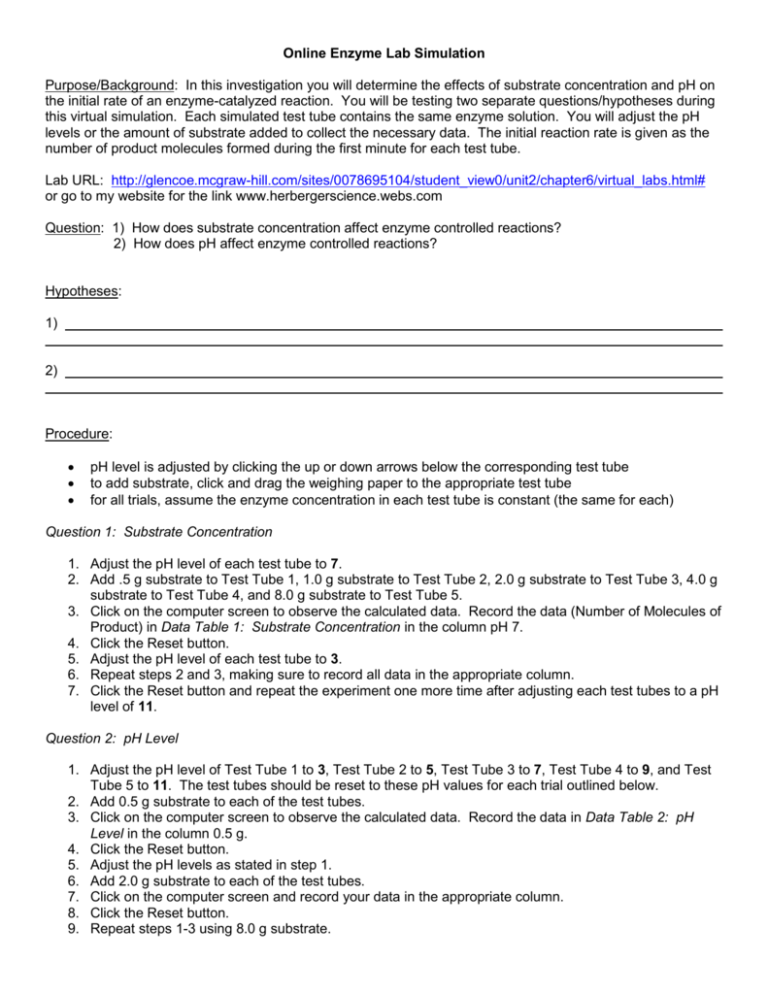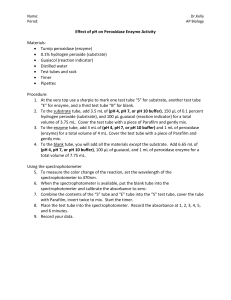Online Enzyme Lab Simulation
advertisement

Online Enzyme Lab Simulation Purpose/Background: In this investigation you will determine the effects of substrate concentration and pH on the initial rate of an enzyme-catalyzed reaction. You will be testing two separate questions/hypotheses during this virtual simulation. Each simulated test tube contains the same enzyme solution. You will adjust the pH levels or the amount of substrate added to collect the necessary data. The initial reaction rate is given as the number of product molecules formed during the first minute for each test tube. Lab URL: http://glencoe.mcgraw-hill.com/sites/0078695104/student_view0/unit2/chapter6/virtual_labs.html# or go to my website for the link www.herbergerscience.webs.com Question: 1) How does substrate concentration affect enzyme controlled reactions? 2) How does pH affect enzyme controlled reactions? Hypotheses: 1) 2) Procedure: pH level is adjusted by clicking the up or down arrows below the corresponding test tube to add substrate, click and drag the weighing paper to the appropriate test tube for all trials, assume the enzyme concentration in each test tube is constant (the same for each) Question 1: Substrate Concentration 1. Adjust the pH level of each test tube to 7. 2. Add .5 g substrate to Test Tube 1, 1.0 g substrate to Test Tube 2, 2.0 g substrate to Test Tube 3, 4.0 g substrate to Test Tube 4, and 8.0 g substrate to Test Tube 5. 3. Click on the computer screen to observe the calculated data. Record the data (Number of Molecules of Product) in Data Table 1: Substrate Concentration in the column pH 7. 4. Click the Reset button. 5. Adjust the pH level of each test tube to 3. 6. Repeat steps 2 and 3, making sure to record all data in the appropriate column. 7. Click the Reset button and repeat the experiment one more time after adjusting each test tubes to a pH level of 11. Question 2: pH Level 1. Adjust the pH level of Test Tube 1 to 3, Test Tube 2 to 5, Test Tube 3 to 7, Test Tube 4 to 9, and Test Tube 5 to 11. The test tubes should be reset to these pH values for each trial outlined below. 2. Add 0.5 g substrate to each of the test tubes. 3. Click on the computer screen to observe the calculated data. Record the data in Data Table 2: pH Level in the column 0.5 g. 4. Click the Reset button. 5. Adjust the pH levels as stated in step 1. 6. Add 2.0 g substrate to each of the test tubes. 7. Click on the computer screen and record your data in the appropriate column. 8. Click the Reset button. 9. Repeat steps 1-3 using 8.0 g substrate. Data/Analysis: Data Table 1: Substrate Concentration Amount of Substrate (g) Test Tube 1 Test Tube 2 Test Tube 3 Test Tube 4 Test Tube 5 Number of Molecules of Product Formed per Minute (x106) pH 7 pH 3 pH 11 0.5 1.0 2.0 4.0 8.0 Data Table 2: pH Level pH Test Tube 1 Test Tube 2 Test Tube 3 Test Tube 4 Test Tube 5 Number of Molecules of Product Formed per Minute (x106) 0.5 g 2.0 g 8.0 g 3 5 7 9 11 GRAPHING of Data *** The graphing software for this program is inaccurate. It does not scale the amount of substrate correctly. Please use Microsoft Excel or this website http://nces.ed.gov/nceskids/createagraph/default.aspx Create 2 Graphs 1. Substrate Concentration effect on Enzyme Production X-Axis = Amount of Substrate Y-Axis = Amount of Molecules of Products Formed Per Minute (x106) 2. pH Level effect on Enzyme Production X-Axis = pH Y-Axis = Amount of Molecules of Products Formed Per Minute (x106) PRINT EACH GRAPH WHEN COMPLETED AND USE THEM FOR ANALYSIS QUESTIONS Conclusion/Summary: USE DATA FROM BOTH DATA TABLES AND BOTH GRAPHS TO SUPPORT ALL ANSWERS. MAKE SPECIFIC REFERENCES TO YOUR DATA IN YOUR RESPONSES. 1. Describe the relationship between substrate concentration and the initial reaction rate of an enzymecatalyzed reaction. Is this a linear (increase/decreases at a constant rate) relationship? What happens to the reaction rate as substrate concentration increases? 2. What is the maximum initial reaction rate for this enzyme at pH 7? How do you know? 3. Explain why the maximum initial reaction rate cannot be reached at low substrate concentrations. 4. What is the shape of each line on the pH Level graph? What does your data indicate about the optimum pH level for this enzyme-catalyzed reaction? What happens as you go below or above that optimum pH level? Explain. 5. The temperature of each trial was kept at a controlled 37 degrees Celsius, which is typical body temperature. Predict what may happen to the enzyme reaction rate if temperature were lowered? Use animation #39 on the following link http://e2bn.skoool.co.uk/keystage3.aspx?id=63 Explain. ___________________ ___________________________________________________________________________ 6. Will raising the temperature above 37 degrees Celsius have the same effect? Explain 7. Which of the other factors tested (substrate concentration or pH) will have a similar effect as raising the temperature of the enzyme. Explain _________________________________________





